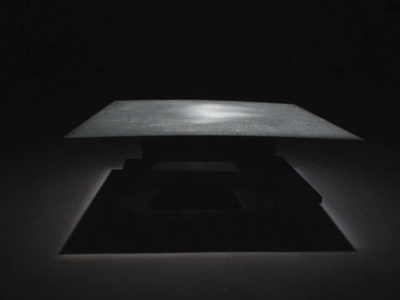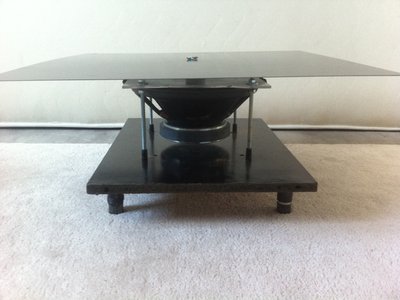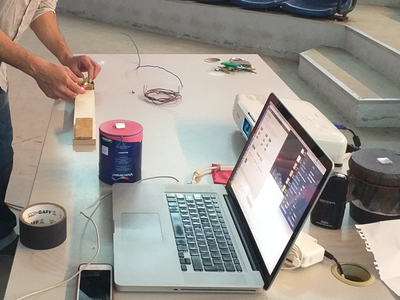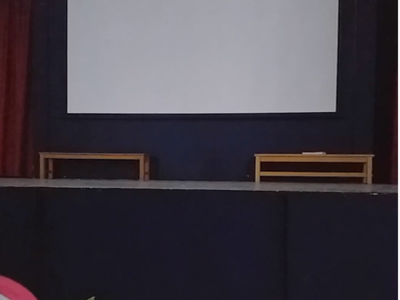Artist's statement
The materiality of sound. Sound as a creative energy-tool for the deaf community.
The central idea of these workshops was to describe and demonstrate through experimentation non-obvious sonic qualities of sound, through the processes that seek to intensify frequency vibration as a technique for transforming energies through sound.
More specifically, considering that this topic was addressed to a large number of the deaf student community in secondary education, the above idea was presented in two axes:
First, the basic principles of the physics of sound were presented and were taken further to explain that sound is primarily a phenomenon of contact with the human body. How can we experience the sonic event as a physical tangible force in our environment? Density, mass, and physicality are creating vibrational atmospheres that can become a force of social transformations. It is in this very context that the human body is experiencing a shifting acoustic ecology.
Secondly, we demonstrated the practical and creative ways that help us to enter a new experience and perception of sound as well as different ways the human body can relate to the sonic energy.
Utilizing the theory and experiments of Chladni’s Plate the students had the chance to discover the visual materiality of sound and a new way to participate in the sonic discourse in which hearing is not more necessary.
The author presented his own sonic sculptures in order for the students to interact in two forms (picture 1).
- A vibrational plate is driven by frequencies coming from a computer.
- A vibrational plate is driven by the voices and the crowd’s noise in the room. In this case, the real-time recorded sound of the room was causing a vibrational impact on a metal plate.
The students had the opportunity to touch and feel the actual room’s resonant frequencies as well as to transform their own voice, or any other sonic gesture, into visual vibrational information.
On the last day of the workshop, the author presented a different approach to sonic visualization by presenting a DIY construction that worked as a sound visualizer (picture 2) including a laser light, a plastic bucket with a stretched balloon across the top of it and a small mirror attached to it.
The Sound Visualizer is used to show how vibrations from sound waves are able to create a simulation of an analog oscilloscope using a few simple pieces of equipment. The user can create vibrations by his/her own voice or by placing the sound visualizer next to a speaker. As compression waves from sound hit the balloon surface it may cause standing waves to form. The mirror attached to the surface has a laser aimed at it, the reflected beam is then aimed at a wall and a pattern will form due to the way the surface deforms due to the standing wave. Changing the pitch will cause the surface to distort in different ways causing new patterns to be seen. As combinations of tones are played at the same time, more complex patterns will be formed.
External Links
- https://en.wikipedia.org/wiki/Ernst_Chladni
- https://www.youtube.com/watch?v=wvJAgrUBF4w&ab_channel=brusspup
- https://www.youtube.com/watch?v=eskZ3OORfYM&ab_channel=BruceYeany
Credits
Lambros Pigounis, Athens, May 2022
Original artwork by • Lambros Pigounis
Production assistance • Yiannis Kranidiotis
Lambros Pigounis lives in Athens and specialises in the field of contemporary classical and electroacoustic composition. He studied violin and theory of music at the Greek Conservatoire in Athens. From 1998-2001 he studied electroacoustic composition at the University of Hertfordshire (UK). While he was working on his degree, he pursued additional studies with Jonathan Harvey, Javier Alvarez, Jonty Harrison and Ambrose Field. He continued his studies at the City University of London, where he completed an MA in Electroacoustic Composition supervised by Simon Emmerson and Denis Smaley.
Additional studies include also seminars and masterclasses in the field of computer algorythmic composition, and violin improvisation for theatre and dance. He has appeared in concerts and festivals, such as the Laban’s Dance Festivals (UK), Greenwich and Docklands International Festival (UK), the Northern Exposure of Contemporary Dance and Video Festival (UK), the Mercat de les slors (SP), the International Platform of Arts (PT), the DAL NIENTE 3 Projects (UK), Synch Festival (GR), Athens Digital Art Festival (GR), Moving Silence Festival (DE), Athens and Epidaurus Festival, Tanz im August (DE), Hebbel Am Ufer (DE), Ibsen Festival (NO) and in numerous concerts and broadcasts around the world.
He teaches at SAE Athens Institute of Technology and he is currently a visiting artist at the Estonian Academy of Music and Theatre. His main artistic activities are Sound Art works and physical sound art performances as well as collaborations with musicians, directors and choreographers. His recent works include the Micropolitics of Noise. A Long Durational Sound Art Performance commissioned by the Marina Abramovic Institute and NEON, commissions by the HAU Hebbel am Ufer Theater in Berlin, Rimini Protokoll as well as several other commissions for theatre, dance and film. He is currently researching the ethics and politics of sound in acoustic ecology through the input of the human agent in electroacoustic performance based on interactive compositional models.
Yiannis Kranidiotis (Athens, Greece), is an artist whose work explores the relationship between science and art, using mainly light, motion, and sound to create spaces and experiences where all coexist and interact. He often engages the visitor using interaction, while other times he uses data to drive the motion, the light, and the sound of his works. He is interested in exploring physical phenomena like natural repeatability or wave movement as well as creating sonification methods for scientific data from sources like exoplanets, gravitational waves, or the solar wind. The climate crisis and the increasing pollution of the planet with plastic are issues that also affect his practice. He has collaborated with choreographers and theatre directors in interdisciplinary projects, designing digital artworks, VR environments, and light installations. He has a BS in Physics from the University of Patras and an M.Sc. in Optics and Lasers from Essex University.
His work has been presented in many festivals and exhibitions like BOZAR (Brussels), Maintenant (Rennes, France), SPECTRA (Aberdeen, UK), Made in NY Media Center (New York), FILE (Sao Paulo, Brazil), B-Seite Festival (Germany), Rome Media Festival, ISEA (2019 S. Korea, 2016 Hong Kong, 2015 Vancouver), MADATAC (Madrid), Lumen Prize Global Tour, Athens Digital Arts Festival, Onassis Cultural Center (Athens), LUNDA Gallery (St. Petersburg, Russia). Many websites and magazines have published articles about his work including “Google Cultural Institute“, “The Creators Project“, “Arduino.org”, “Gizmodo“, “Open Culture“, “Hyperallergic“, “Bigthink” and “Konstvärlden”.





